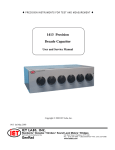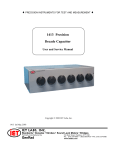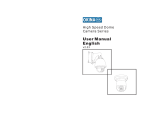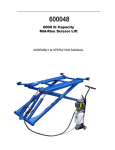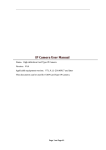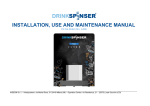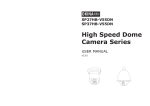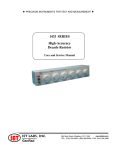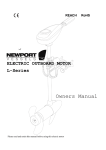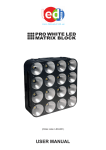Download GenRad 1413 Precision Decade Capacitor
Transcript
♦ PRECISION INSTRUMENTS FOR TEST AND MEASUREMENT ♦ GenRad 1413 Precision Decade Capacitor User and Service Manual Contents WARRANTY ...........................................................................................iii WARNING ............................................................................................... v CAUTION ................................................................................................ v Section 1 INTRODUCTION .......................................................................... 1 1.1 Purpose .................................................................................. 1 1.2 Description ............................................................................. 1 1.3 Controls and Connectors ....................................................... 1 1.4 Inspection and Unpacking .................................................... 2 Section 2 SPECIFICATIONS ......................................................................... 3 Section 3 OPERATION PROCEDURE ....................................................... 4 3.1 Dimensions ............................................................................ 4 3.2 Mounting ................................................................................ 4 3.3 Connections ........................................................................... 5 3.3.1 Three-Terminal Capacitor ............................................. 5 Section 4 THEORY .......................................................................................... 6 4.1 Circuit Description .................................................................. 6 4.2 Frequency Characteristics ..................................................... 6 Section 5 SERVICE .......................................................................................... 7 5.1 Customer Service .................................................................. 7 5.2 Instrument Return .................................................................. 7 Section 6 MAINTENANCE ............................................................................ 8 6.1 Minimum Performance Standards ......................................... 8 6.1.1 General .......................................................................... 8 6.1.2 Capacitance ................................................................... 8 6.1.3 Terminal Capacitance .................................................... 8 6.1.4 Insulation Resistance ..................................................... 9 6.2 Adjustments ......................................................................... 11 6.3 Knob Removal and Replacement ........................................ 11 Section 7 PARTS LISTS AND DIAGRAMS .............................................. 12 ii Figures Figure 1-1. Elementary schematic diagram of the Type 1413 Decade Capacitor. Connections for all 24 capacitors are similar to those for the three capacitors shown. .............................................. 1 Figure 1-2. Front panel on the Capacitor. Six 11-position switches with knobs and dials to set desired value of capacitance between HIGH and LOW terminals. ............ 2 Figure 1.3 Connection on the rear panel of the 1413. .............................. 2 Figure 3-1. Dimensions of the bench and relay-rack models. .................. 4 Figure 6-1. Top interior view of the Capacitor. ....................................... 10 Figure 7-2. Schematic circuit diagram for the 1413 Precision Decade Capacitor. Switches are shown in zero position. ...................... 12 iii WARNING OBSERVE ALL SAFETY RULES WHEN WORKING WITH HIGH VOLTAGES OR LINE VOLTAGES. Dangerous voltages may be present inside this instrument. Do not open the case Refer servicing to qulified personnel HIGH VOLTAGES MAY BE PRESENT AT THE TERMINALS OF THIS INSTRUMENT WHENEVER HAZARDOUS VOLTAGES (> 45 V) ARE USED, TAKE ALL MEASURES TO AVOID ACCIDENTAL CONTACT WITH ANY LIVE COMPONENTS. USE MAXIMUM INSULATION AND MINIMIZE THE USE OF BARE CONDUCTORS WHEN USING THIS INSTRUMENT. Use extreme caution when working with bare conductors or bus bars. WHEN WORKING WITH HIGH VOLTAGES, POST WARNING SIGNS AND KEEP UNREQUIRED PERSONNEL SAFELY AWAY. CAUTION DO NOT APPLY ANY VOLTAGES OR CURRENTS TO THE TERMINALS OF THIS INSTRUMENT IN EXCESS OF THE MAXIMUM LIMITS INDICATED ON THE FRONT PANEL OR THE OPERATING GUIDE LABEL. 1413 Series Section 1 Introduction 1.1 Purpose The Type 1413 Precision Decade Capacitor is both a high-quality, wide-range standard and a reliable component for systems. It can be used as a bench model for versatility, or it can be rack-mounted. This six-decade capacitor features fine adjustment over a wide range of capacitance, with excellent accuracy. Any value in the range of 0 to 1.111 11 µF can be set, with a resolution of 1 pF. connected together, form the third terminal of the capacitor. The stability of the 1413 (refer to Specifications) is such that it should not require readjustment with normal service. However, should it become desirable, the four lower decades contain trimmer capacitors that are accessible for this purpose (refer to Section 5.4). 1.2 Description The six decades have steps of 1, 10, 100, 1000 pF, and 0.01 and 0.1 F. Air capacitors are used for the two lower decades, with precision silvered-mica capacitors for the others. Air trimmers are used for trimming the two lowest silvered-mica decades. The connections to the inner shield and to the case are shown in Figure 1-1. Low terminal-to-guard and detector-input capacitances are obtained by dividing the shielding into two parts. When the two parts are connected together, the 1413 becomes a well-shielded three-terminal capacitor with extremely low zero capacitance. The connections are made by means of BNC connectors on the rear of the cabinet. The inner contacts provide the connections to the capacitors. The outer shells connect to the shields and, when INTRODUCTION Figure 1-1. Elementary schematic diagram of the Type 1413 Decade Capacitor. Connections for all 24 capacitors are similar to those for the three capacitors shown. 1.3 Controls and Connectors The controls and connectors on the front and rear of the 1413 are shown in Figures 1-2 and 1-3. 1 1413 Series 1.4 Inspection and Unpacking Inspection - If the shipping carton appears damaged, contact the carrier immediately and request that their agent be present when the instrument is unpacked. If the instrument appears to be damaged when unpacked, have the agent witness its condition, take photos of the instrument and carton, and retain the carton until the matter is resolved. Perform an electrical check immediately to determine if any internal damage has occurred and file any required claims with the carrier. Unpacking - The instrument is wrapped in plastic, and desiccant may be included if the environmental conditions and destination warrant. Do not unwrap the instrument until ready to use or install. For bench use, the bail will raise the front of the instrument if desired. Refer to 2.2 for rack-mounting instructions. Figure 1-2. Front panel on the Capacitor. Six 11-position switches with knobs and dials to set desired value of capacitance between HIGH and LOW terminals. Access holes for trimmer Capacitors. HIGH BNC connector. (874 optional) Cover Plates to protect setting of trimmer Capacitors. LOW BNC connector. (874 optional) Figure 1-3. Connection on the rear panel of the 1413. 2 INTRODUCTION 1413 Series Section 2 Specifications Range: 0 to 1.11111 µF. controlled by six in-linereadout dials. Accuracy: ±(0.05% + 0.5 pF) at 1 kHz. Stability: ±(0.01% +0.1 pF) per year. Temperature coefficient: <<20 ppm/oC from 10 to 50°C. Mechanical: Convertible bench/rack cabinet. Dimensions (w x h x d): 17 x 5.59 x 11.96 in. (432 x 142 x 304 mm); rack 19 x 5.22 x 10.9 in. (483 x 133 x 505 mm). Weight: Bench 23 lb (10.5 kg) net, 29 lb (13.5 kg) shipping; rack 24 lb (11 kg) net, 30 lb (14 kg) ship- Zero Capacitance: <0.1 pF. Voltage Rating: 500 V pk max up to 10 kHz. Interface: Connections, 2 rear-mounted bnc connectors, adaptable to most other types. Available: 0480-9703 Rack Adaptor Set to convert bench models to rack models. Catalog Number 1413-9700 1413-9701 0480-9703 SPECIFICATIONS Description Bench Model Rack Model Rack-Adaptor Set 3 1413 Series Section 3 Operating Procedure 3.1 Dimensions The dimensions of both the bench and relay-rack models of the 1413 are shown in Figure 3-1, and are also listed in Section 2. mounting (P/N 1413-9701), it is shipped with RackAdaptor Set P/N 0480-9703, which includes all hardware necessary for mounting the instrument in a standard 19-in. rack or cabinet (refer to Table 3-1). (Order the Rack-Adaptor set alone if a bench model is to be converted for rack mounting.) 3.2 Mounting The 1413 may be ordered enclosed in a cabinet for bench use (P/N 1413-9700). If ordered for rack Figure 3-1. Dimensions of the bench and relay-rack models. 4 OPERATING PROCEDURE 1413 Series Fig. 3-2 Ref C D E Table 3-1 PARTS INCLUDED IN RACK-ADAPTOR SET P/N 0480-9703 No. Used Description Part No. 2 Rack-Adaptor Assembly (handle) 0480-4903 1 Hardware Set 0480-3080 Includes: 4 Screws, BH 10-32x 5/16" 4 Screws, BH 10-32x9/16", with nylon cup washers CAUTION Remove the cabinet only when converting the instrument from bench to rack mounting or vice versa. Use extreme care. Do not change the position of the leads or components, as doing so may alter the calibration. GR recommends taking accurate spot readings before and after this procedure in order to verify that the instrument’s electrical characteristics have not been affected. Cover the unit with a plastic sheet when working on the cabinet. Clean the inside of the cabinet thoroughly when installation is complete. Replace the instrument in the cabinet as soon as possible after the work is completed. To install the instrument in a rack: a. Loosen the four captive 10-32 screws in the rear of the cabinet until the chassis is free; slide the chassis forward, out of the cabinet. f. Slide the entire assembly into the relay rack and install it with the four 9/16-inch screws with captive nylon cup washers (E). Use two screws on each side and tighten them by inserting a screwdriver through the holes in the handles. To reconvert the instrument for bench use, reverse the above procedure. Seal the mounting holes if the working environment warrants such action. 3.3 Connections CAUTION The voltage rating of the 1413 is 500 V pk maximum up to 10 kHz, varying approximately inversely with frequency above 10 kHz. Do not exceed these values. b. Match drill the cabinet for proper positioning of the rack-mount adaptors. 3.3.1 Three-Terminal Capacitor c. Remove the four feet and the bail from the cabinet if required for clearance. When the 1413 is used as a three-terminal capacitor, the outer conductors (shells) of the two bnc connectors must be connected together, to provide complete shielding. d. Attach one Rack Adaptor Assembly (G) to each side of the cabinet using the hardware supplied. e. Install the instrument in the cabinet and lock it in place with the four captive screws in the rear panel that were loosened in step a. OPERATING PROCEDURE If binding-post connections are desired, these can be provided by standard adaptors plugged into the bnc connectors on the rear of the 1413. Plug the adaptors into the 1413 with the shield binding posts adjacent to each other. These shield posts can then be connected together with a shorting link . 5 1413 Series Section 4 Theory 4.1 Circuit Description Each decade consists of four capacitors with values in the ratio of 1-2-2-5. They are connected in parallel in different combinations to provide ten equal steps of capacitance. Individual capacitors that are not used at a particular setting of the switches are completely disconnected from the circuit and their high side is connected to the inner or “guard” shield. The inner shield and the wiring are arranged to keep the capacitance at the zero setting to a very low value (< 0.1 pF) and to keep the capacitance from HIGH to case and from HIGH and LOW to the inner shield to a minimum. 6 An elementary schematic is shown in Figure 1-1 and the complete schematic circuit diagram is given in Figure 7-1. 4.2 Frequency Characteristics Typical variations of capacitance and dissipation factor with frequency are shown in Section 2. THEORY 1413 Series Section 6 Maintenance 6.1.2 Capacitance The equipment required to check the capacitance values of the 1413 is listed in Table 6-1. --Store the instrument for short periods in a benign and dust-free environment (23 ± 10° C and <60% relative humidity); a laboratory environment is best. For long-term storage, seal the instrument in plastic-with desiccant if possible--and store at temperatures between 10° C and 50° C and humidity <80%; Calibrate before use. Since the 1413 is a precision instrument, GR recommends that any storage be in a laboratory environment. --Clean the external surfaces of the instrument with a soft, dry cloth that may be moistened with a mild, general-purpose cleaner; compressed air may also be used. Keep the 1413 connectors and any mating connectors clean. Do not open the cabinet, and keep the rear cover plates in place, in order to keep the inside of the instrument dust-free. --Replace the rear cover plates immediately after any adjustments are completed. 6.1 Minimum Performance Standards 6.1.1 General Connect the UNKNOWN H and L terminals on the 1620 Capacitance Measuring Assembly to the HIGH and LOW terminals, respectively, on the 1413. Make the measurements at 1 kHz with the 3-terminal connection. Use appropriate patch cords up to 0.1 µF and twist them together for measurements above 0.01 µF to reduce the error due to inductance of the cables. At 0.1 µF and higher, low-resistance connections are necessary to reduce the dissipation-factor errors caused by lead resistance. Install bnc-to-binding-post adaptors on the 1413. Place the instruments so that the binding posts on the adaptors are close to the bridge binding posts. Make the connections, with #12 AWG copper wire, from the bridge H and L terminals to the 1413 HIGH and LOW terminals. Connect a short clip lead from bridge GND to the shells of both bnc connectors on the 1413. Maximum dissipation-factor readings are given in the Specifications. 6.1.3 Terminal Capacitance Use the 1620 Capacitance Measuring Assembly to make the various terminal-capacitance measurements. The connections are given in Table 6-2. The following tests can be used for incoming inspection, periodic checks, or recalibration of the 1413. The required equipment is listed in Table 6-1. 8 MAINTENANCE 1413 Series 6.1.4 Insulation Resistance To measure the insulation resistance, use a GenRad Type 1863 Megohmmeter or equivalent. Measure the resistance between the inner conductors of the HIGH and LOW bnc connectors on the 1413. Connect the outer shells of both of these connectors to the GUARD terminal of the Megohmmeter; use alligator clip leads. Apply 500 Vdc and wait two minutes before measuring the resistance. Table 6-1 TEST EQUIPMENT Number Required Description 1 Capacitance Measuring Assembly (includes oscillator, amplifier and bridge) 2 Shielded patch cord/adaptor, GR874-to-BNC 2 Adaptor, bnc-to-binding posts 2 Special shielded cables, bnc connectors on one end, very small alligator clips on the other 1 Single banana-plug patch cord, 18 inches or as short as possible 4 Shielded clip leads with small alligator clips Recommended Type* GR 1620-A *Or equivalent MAINTENANCE 9 1413 Series Table 6-2 Connections for Terminal-Capacitance Measurements Measurement HIGH to Case HIGH to Guard LOW to Guard Connection Bridge L to 1413 HIGH Bridge H to outer shell of 1413 LOW Bridge GND to inner conductor of 1413 LOW Lead Type Patch cord Shielded clip lead Single banana plug patch cord Bridge H to shell, and L to inner conductor of 1413 HIGH Bridge GND to shell and inner conductor of 1413 LOW Shielded clip leads Bridge L to 1413 LOW Bridge H to shell of 1413 HIGH Bridge GND to inner conductor of 1413 HIGH Patch cord Shielded clip lead Single banana plug patch cord Patch cord with alligator clips Figure 6-1. Top interior view of the Capacitor. 10 MAINTENANCE 1413 Series 6.2 Adjustments Most of the capacitance in the four highest decades of the 1413 Decade Capacitor is provided by highquality, precision, sealed, mica capacitors. The capacitance in the two lowest decades (1 pF/step and 10 pF/step) is provided by small adjustable air capacitors (see Figure 6-1). Similar capacitors are provided for trimming the next two decades (100 pF/ step and 1000 pF/step). When they are readjusted, a precision three-terminal bridge such as the 1620 Capacitance Measuring Assembly should be used. Set the bridge for threeterminal measurements and connect the capacitor to it with BNC-to-874 patch cords. Remove the two cover plates over the adjustment holes (Figure 6-2) on the rear of the case. Do not remove the instrument from its case. Adjust the four trimmers in the decade (e.g.. those for the 10 pF/ step decade, labelled 10, 20, 40, 50) in order, starting with the smallest. These numbers refer to the corresponding pF dial settings for that decade. Make the adjustments with a non-metallic screwdriver through the hole marked with the corresponding pF value. MAINTENANCE Set the switch for that decade to the pF value being adjusted, with all other switches set to zero. For example, to adjust the 10 pF/step decade, set that dial at 10. and adjust the trimmer marked 10 to give 10 pF from the HIGH to LOW terminals. Change the dial setting to 2 and adjust the trimmer marked 20 for 20 pF. Proceed similarly with 40 pF and 50 pF. In the 1-pF/step decade, the capacitors are set to 1.01, 2.01, 4.01, and 5.01 pF, respectively. All other decades are set to the exact nominal value. When all values have been set. it is usually desirable to repeat the adjustment for a slight “touch-up.” 6.3 Knob Removal and Replacement If it should become necessary to remove a knob from the front panel to change one that has been damaged, proceed as follows: a. Note the setting of the dial on the shaft, so that it can be replaced property; then loosen the collet nut in the hub of the dial and slide the dial off of the shaft. b. To replace the knob, reverse the above procedure. 11 Rotary switch sections are shown as viewed from the panel end of the shaft The first digit of the contact number refers to the section The section nearest the panel is 1, the next section back is 2, etc The next two digits refer to the contact Contact 01 is the first position clockwise from a strut screw (usually the screw above the locating key), and the other contacts are numbered sequentially (02, 03, 04, etc ), proceeding clockwise around the section A suffix F or R indicates that the contact is on the front or rear of the section, respectively Figure 7-2 Schematic circuit diagram for the 1413 Precision Decade Capacitor Switches are shown in zero position 1413 Series Section 7 PARTS LISTS AND DIAGRAMS 12 PARTS LISTS AND DIAGRAMS 1413 Series ELECTRICAL PARTS LIST Ref Des Description Part No. CAPACITORS Cl C2 C3 C4 C5 C11 C12 C13 C14 C15 C21 C22 C23 C24 C25 C26 C27 C28 C31 C32 C33 C34 C35 C36 C37 C38 C41 C42 C43 C44 C51 C52 C53 C54 PARTS LISTS AND DIAGRAMS Air Dielectric, 1.4-5.0 pF Air Dielectric, 1.4-5.0 pF Air Dielectric, 1.4-5.0 pF Air Dielectric, 1.7-8.7 pF Quartz, Var., 0.6-1.8 pF, Air Dielectric, 2.7-19.6 pF Air Dielectric, 2.7-19.6 pF Air Dielectric, 2.7-19.6 pF Air Dielectric, 2.7-19.6 pF Ceramic, 33 pF ±5%, NPO, 500V 96.3 pF ±1 pF 196.0 pF ±1 pF 196.0 pF ±1 pF 496.0 pF ±1.3 pF Air Dielectric, 1.7-8.7 pF Air Dielectric, 1.7-8.7 pF Air Dielectric, 1.7-8.7 pF Air Dielectric, 1.7-8.7 pF 986.1 pF ±2.1 pF 1989 pF ±5 pF 1989 pF ±5 pF 4989 pF ±5 pF Air Dielectric, 2.7-19.6 pF Air Dielectric, 2.7-19.6 pF Air Dielectric, 2.7-19.6 pF Air Dielectric, 2.7-19.6 pF 10,000 pF ±2.5 pF 20,000 pF ±5 pF 20,000 pF ±5 pF .05 µF ±12.5 pF 0.1 µF ±12.5 pF 0.2 µF ±50 pF 0.2 µF ±50 pF 0.5 µF ±125 pF 4380-3500 4380-3500 4380-3500 4380-3600 4910-1180 4380-3700 4380-3700 4380-3700 4380-3700 4410-0335 0505-4030 0505-4031 0505-4031 0505-4032 4380-3600 4380-3600 4380-3600 4380-3600 0505-4033 0505-4034 0505-4034 0505-4035 4380-3700 4380-3700 4380-3700 4380-3700 0505-4036 0505-4037 0505-4037 0505-4038 0505-4039 0505-4040 0505-4040 0505-4041 13 1413 Series MECHANICAL PARTS LIST Front View (See Fig 1-2) Qty Ref 1 1 1 1 1 2 1 6 6 Description IET Pait No. 4181-2901 2 Cabinet asm., includes: Bail* Gasket (mat'l.) Foot, left front* Foot, iight front* Foot, l & r, rear* *Pait of foot/bail kit Knob/Dial assembly 3 Cap, knob 350019 0051-0006 350020 Rear View (See Fig 1-3) Qty Ref 14 Description IET Pait No. 1 1 Connector, bnc, isolated (Std.) (Other types optional) 31-10/800-2540-03 1 2 Connector, bnc (Other types optional) 31-221/UG-1094 2 3 Cover Plate 1413-8190 PARTS LISTS AND DIAGRAMS

















